Meet Singapore's largest kingfisher!
Video [1] credit: Hans Lin
Did you know? This bird is named as such because of its long and stout bill, which resembles that of a stork!
Table of Contents
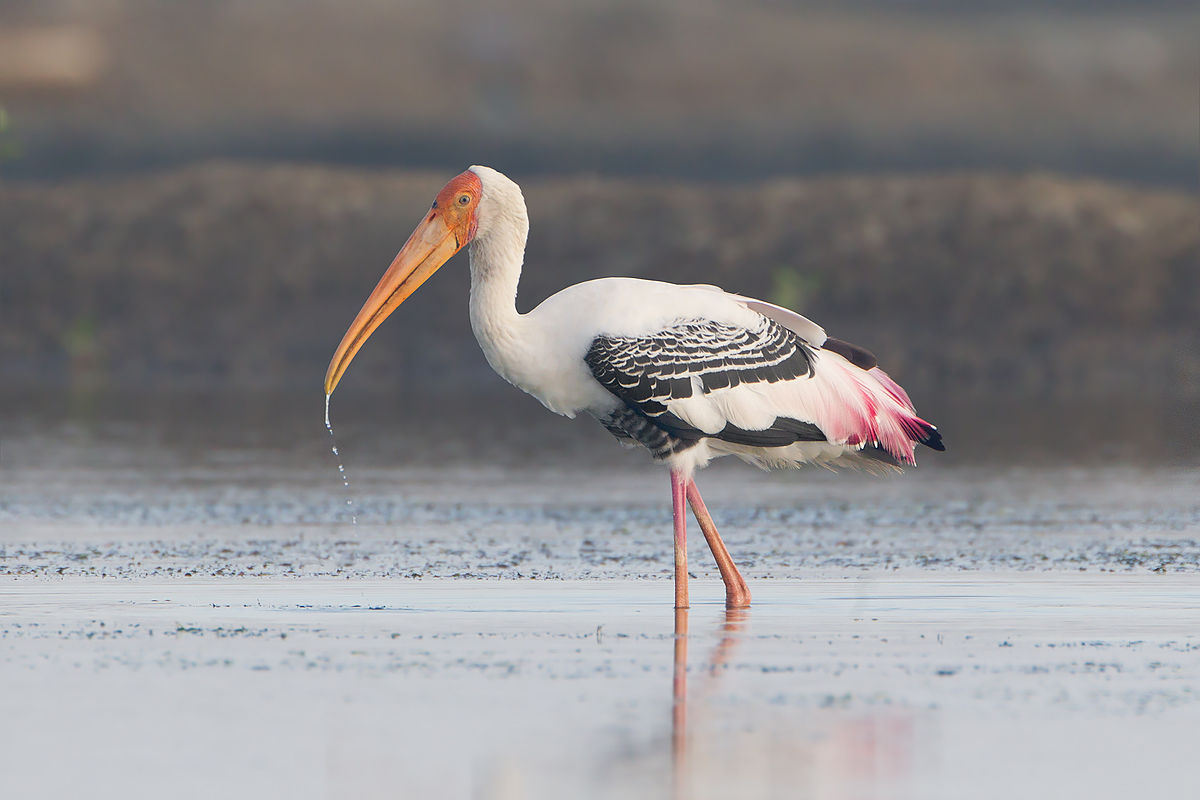 |
|
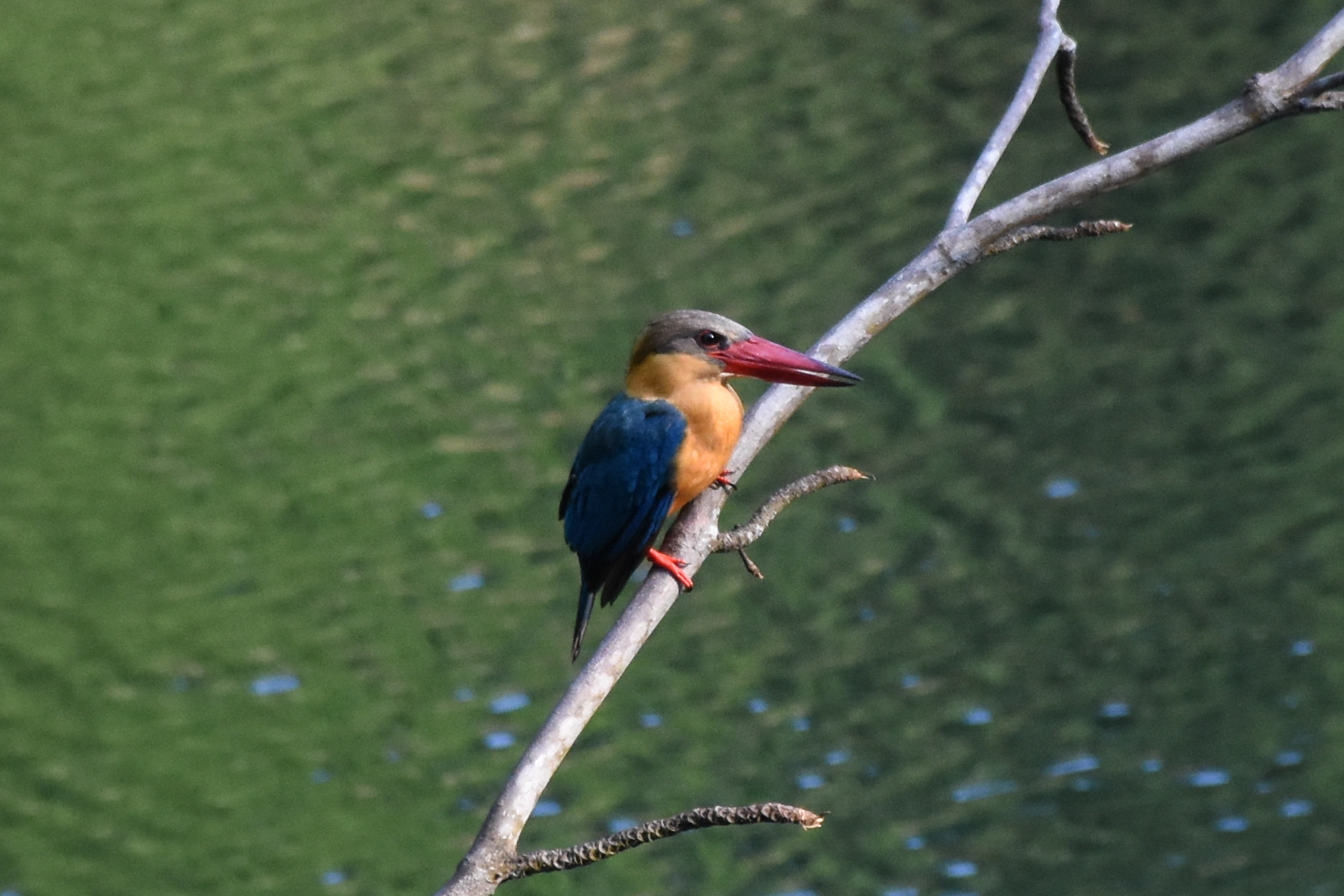 |
|
| Painted stork (top). Photo credit: Wikimedia CommonsStork-billed kingfisher (bottom). Photo credits: Dillen Ng (Permission Granted) |
|
| Figure 1 |
1. Biology
1.1. Feeding behavior
The vast bill of this kingfisher makes a formidable weapon in dealing with its preys [1] . Its diet is primarily made up of marine and freshwater organisms (e.g. frogs, fish, crabs and shrimps). Although a kingfisher, this species is not a fish specialist [2] . When primary food resources become scarce, it hunts for small mammals (mainly rodents) and young birds – sometimes marauded out of tree holes [3] . This thus highlights its range of skills to hunt in different types of terrain.
Being a sit-and-wait predator, it perches quietly while hunting and is often inconspicuous despite its size. When it spots its prey, it plunges down from its perch, and its heavy bodyweight enables it to swoop down fast on a fish swimming near the water surface (read documentation). Like other kingfishers, it has the ability to hover above the water body while searching for its prey [4] . Once successful, it would carry its prey back and immobilize it by striking it against the perch a few times [5] before swallowing it whole. The tapping noise caused by the prey being beaten and bruised can be heard from some distance [6] .
Check out an interesting observation of a stork-billed kingfisher rejecting its prey.
Feeding behavior of Stork-billed kingfisher. Video [2] credit: 13seaeagle
Fun fact: an average family of 6 stork-billed kingfishers can eat up to 100 fish a day![7]
1.2. Nesting and breeding
The stork-billed kingfisher usually lives in a family with an average of 6 members [8] . Like many other kingfishers, they are highly territorial and have been known to fiercely chase away large predators up to the size of White-bellied Sea Eagle and Adjutant Stork [9] . The species is also monogamous, and both sexes usually work together to excavate the nest cavity in a river bank, decaying tree, termite nest. A breeding pair has been recorded to build their nest out of a small crack in a brick wall by working 5 to 6 hours a day for several weeks [10] . Sometimes, a natural tree hollow would also be used. The incubating chamber would typically be located at the end of the tunnel. Each clutch usually contains 2 to 5 eggs, which are glossy, translucent white and near-spherical in shape [11] . Both parents would incubate the eggs during the day while only the female incubates the eggs during the night [12] . The breeding season varies depending on its residing location [13] , but it ranges from January to September.Mating behavior of Stork-billed kingfishers. Video [3] credit: Simplenaturewatch
In Singapore, an overall increasing trend in its population has been observed [14] . Although breeding has been reported, nest were not found [15] until 2016, and it was subsequently reported at the same location (Pulau Ubin) a year later.
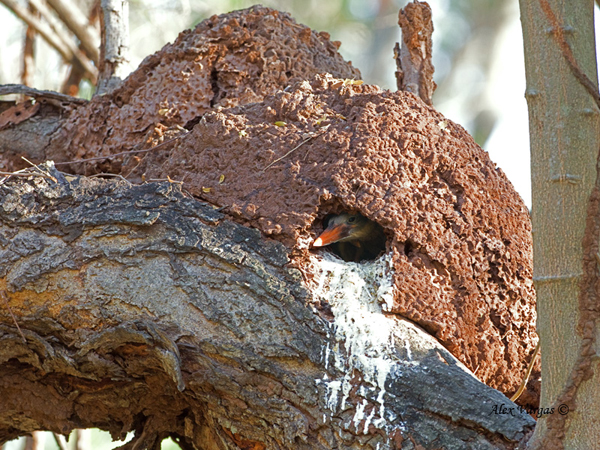 |
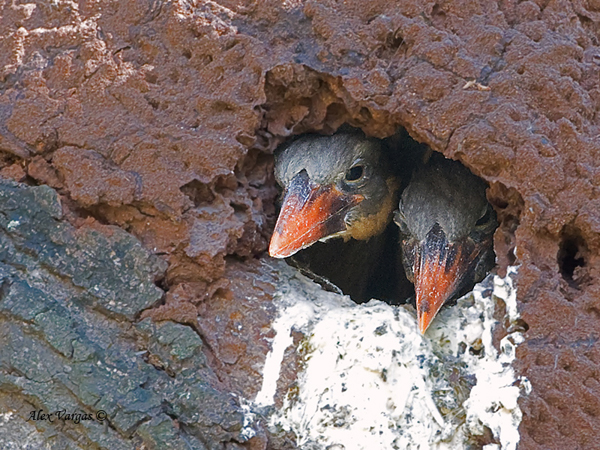 |
| Stork-billed kingfisher chicks in a nest (Taken in Thailand). Photo credit: Alex Vargas [Permission pending] |
| Figure 2 |
1.3. Habitat
It is widely but sparsely distributed in tropical south Asia ranging from India and Sri Lanka to Indonesia [16] . In order to fish, they usually live by the edge of water bodies. Being a moderately forest dependent species, they are usually vulnerable to development, deforestation and water pollution [17] . They are also known to inhabit artificial aquatic and terrestrial ecosystems, for instance plantations and drain canals. In Singapore, they can typically be found at waterbodies in or near forests, parks, gardens and mangroves [18] .Two Stork-billed kingfishers in a territorial strife. Video [4] credit: Simplenaturewatch
Fun fact: they occur in altitudes from 0 to 1200 meters (not restricted to lowland)
2. Description
2.1. Diagnostics
 |
| Photo credit: Kwong Wai Chong [Permission pending] |
| Figure 3 |
(1) Forehead, crown, lores, cheeks and ear-coverts: dark olive-brown
(2) Collar around hindneck and sides of neck: dark yellow-buff
(3) Mantle: dull greenish-blue
(4) Bill: scarlet, darker towards the tip
(5) Eyes: red eye ring
 |
| Photo credit: Amar Singh HSS [Permission granted] |
| Figure 4 |
(6) Primaries and secondaries: dark-brown edged with blue (flight photo)
(7) Lower-back and rump: brilliant pale azure-blue (conspicuous during flight) [8]
(8) Chin and throat: pale yellow or buff
(9) Rest of underparts including underwing-coverts: rich orange buff
(10) Legs and feet: orange-red
Distinct morphological differences exist between these three species, which can be easily told apart even by an untrained eye.
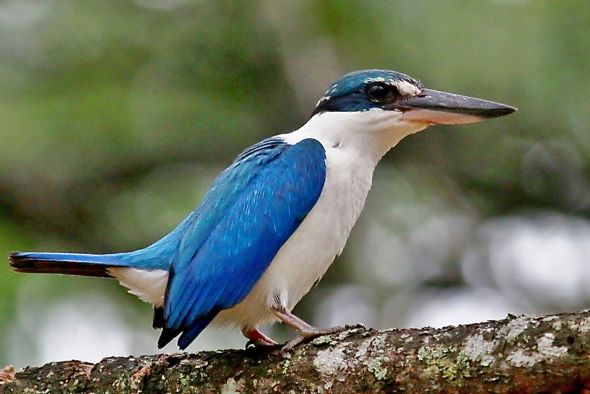 |
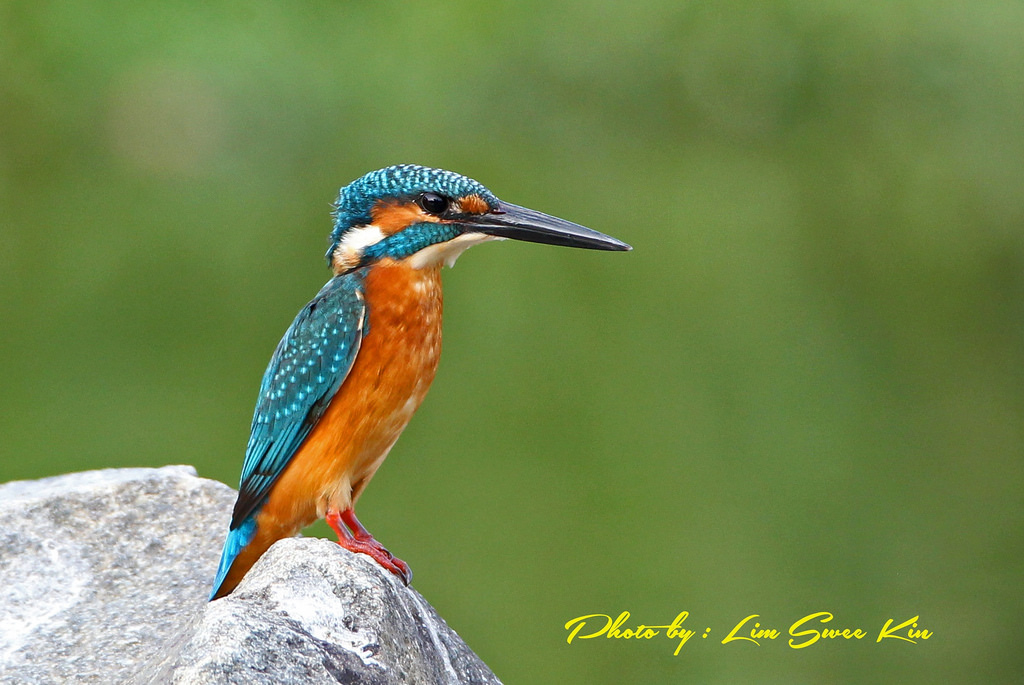 |
| (Left) Collared kingfisher. Photo credit: Kwong Wai Chong (Permission pending) (Right) Common kingfisher. Photo credit: Lim Swee Kun (Permission pending) |
|
| Figure 5 |
|
| Common name |
Great-billed kingfisher |
Stork-billed kingfisher |
Brown-winged kingfisher |
| Species name |
P. melanorhyncha |
P. capensis |
P. amauropterus |
| Photo comparison |
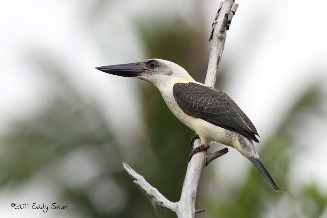 Photo credit: Eddy Swan [Permission pending] |
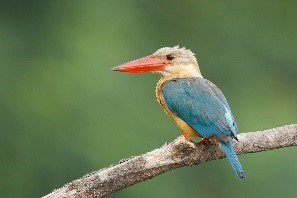 Photo credit: Francis Yap (Permission pending) |
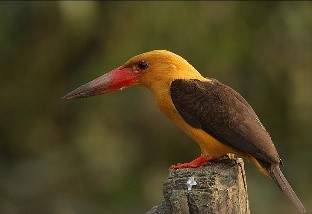 Photo credit: Wikimedia Commons |
| Head |
Creamy white |
Dark olive brown |
Orange yellow |
| Bill |
Black, sometimes with a small dark red spot at the base |
Scarlet, darker towards the tip |
Coral-red bill with dark tip |
| Plumage |
Dull greenish brown mantle, underpart creamy-white |
Dull blue to greenish-blue mantle, with orange yellow underparts |
Dark chocolate brown mantle, orange yellow underparts |
| Range |
Endemic to Sulawesi region of Indonesia |
Sparsely distributed from India to Southeast Asia |
North eastern coast of India through Bangladesh and Myanmar to the Malay Peninsula |
| Figure 6 |
|||
| Note: the Great-billed kingfisher and Brown-winged kingfisher cannot be found in Singapore. |
|||
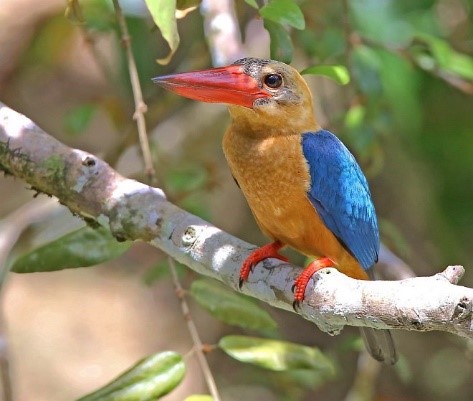 |
| Photo credit: Stijn De Win [Permission pending] |
| Figure 7 |
Most merely differ in plumage detail, but P. C. gigantea of the Sulu Islands is most distinct - has a white head, neck and underparts [21] .
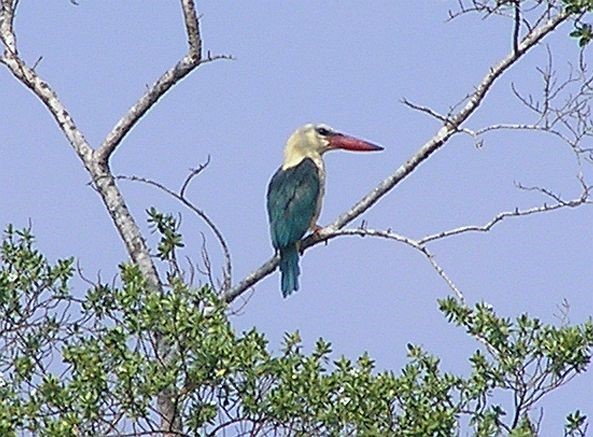 |
| Photo credit: Djop Tabaranza [Permission pending] |
| Figure 8 |
2.2. Vocalisation
It would usually first attract attention with its harsh cries [22] . The call of this noisy kingfisher is made up of a low and far reaching "peer-peer-por" (territorial song) (**XC369408**) repeated every 5 seconds or so [23] as well as a loud, raucous shrieking ‘laugh’ ke-ke-ke-ke-ke with explosive accent on the intial ke [24] (**XC357465**).3. Distribution and range
3.1. Local
An uncommon resident in Singapore, this bird is often seen on the northern and western coasts, and is fairly common on the surrounding islets [25]Sighted at: Central Catchment Forest, Kranji Marsh, Singapore Botanic Gardens, Japanese Garden, Jurong Eco Garden, Hindhede Quarry, Pulau Ubin, Sungei Buloh any patch of suitable habitat [26] .
* Disclaimer: this list is not exhaustive*
3.2. Global
The continental range of stork-billed kingfisher is mainly restricted to South Asia, from India and Sri Lanka to Indonesia [27] . |
| Global distribution and range of stork-billed kingfisher. Photo credit: eBird (Fair use) [28] . |
| Figure 9 |
4. Conservation status
| Photo credit: IUCN Red List of Threatened Species (Free use) |
| Figure 10 |
Although it is evaluated as Least Concern mainly due to its extremely large range, global population is decreasing and some populations are threatened by ongoing habitat destruction [29] . In Singapore, it is a Uncommon Resident [30]
5. Taxonomy and systematics
5.1 Taxonavigation
Kingdom: AnimaliaPhylum: Chordata
Class: Aves
Order: Coraciiformes
Family: Alcedinidae
Genus: Pelargopsis Gloger, 1841
Species: Pelargopsis capensis (Linnaeus, 1766)
5.2 Nomenclature
Pelargopsis capensis was first described by Linnaeus in 1766 under Alcedo capensis [31] . Linnaeus based his description on Mathurin Jacques Brisson’s specimen, of which he believed had come from the Cape of Good Hope region of South Africa [32] . However, species does not occur in Africa, and it was suggested that the specimen had been obtained from Java, Indonesia. It is currently known to have come from near Chandannagar in West Bengal, India [33] . The genus Pelargopsis was later introduced by the German zoologist Constantin Gloger [34]| Original description by Linnaeus. Retrieved from: Harvard University Botany Libraries (Fair Use). |
| Figure 11 |
Protonym: Alcedo capensis Linnaeus 1766
Synonym(s):
- Halcyon capensis (Fry, 1980)
*The sources (author name and year) of the following synonyms are unavailable*
- Ramphalcyon capensis
- Alcedo gurial
- Pelargopsis gurial
Common name(s): Brown-headed stork-billed kingfisher[35] , Common stork-billed kingfisher [36]
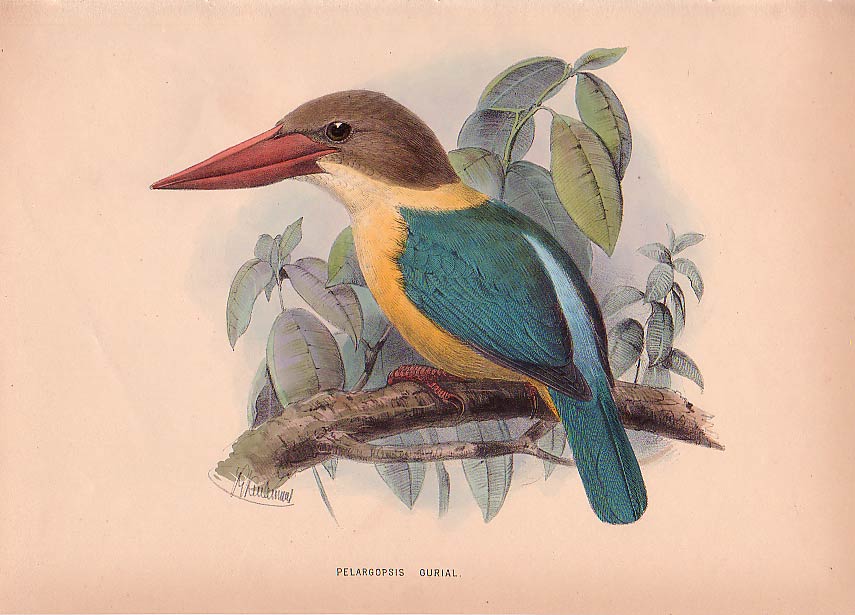 |
| Somewhat confused nomenclature: nominate race previously believed to refer to populations of Java, and under that arrangement Indian mainland birds were placed in race gurial, which was later synonymized with capensis [37] . Photo credit: Smithsonian Institution NMNH[38] (Fair Use) |
| Figure 12 |
The genus name Pelargopsis is derived from classical Greek, a combindation of pelargos meaning 'stork', and opsis meaning 'appearance'. The specific epithet, capensis, denotes the Cape of Good Hope
5.3 Phylogenetics
RAG-1 is known to be a bird-specific gene as it has provided good resolution across varying taxonomic levels in birds [39] . Nuclear DNA (RAG-1) evolves slowly and generally provides more phylogenetic signal than mitochondrial markers (ND2) at deeper nodes in a phylogeny. Mitochondrial marker, on the other hand, evolves more quickly and is useful for resolving more closely-related taxa.Pelargopsis split or merged with Halcyon ?
Pelargopsis was lumped together with Halcyon by Fry (1980)[40] , while phylogeny supports splitting the two genera. Thus, merging or retaining those genera is subjective. However,the decision to split off Pelargopsis from Halcyon could be maintained to account for their difference in morphology [41] .
*Disclaimer: Ranks, except species, are arbitrary and uninformative. Taxon names, however, are necessary as communication tools and can exist without ranks.
| The phylogeny of kingfishers (Alcedinidae) reconstructed by Moyle (2006) by comparing mitochondrial and nuclear DNA sequences representing 38 ingroup species supported the splitting of Pelargopsis from Halcyon[42] |
| Figure 13 |
| Bayesian consensus phylogeny of Alcedinidae genera from nuclear (RAG-1) and mtDNA (ND2) sequence data [43] |
| Figure 14 |
The available information of holotypes are P. capensis subspecies.
Type specimen for Singapore's subspecies P.c. malaccensis, formerly known as Ramhalcyon capensis hydrophilia, can be found in National Museum of Natural History, Smithsonian Institution [44] . It was collected from Singapore.
Sequences for mitochondrial gene cytochrome c oxidase subunit I (COI) of the stork-billed kingfisher have been barcoded and are available here
Polytypic; currently with 15 sub-species recognised. [45]
6. References
Davison, G. W. H. & Y. F. Chew, 2013. A Photographic Guide To Birds Of Peninsular Malaysia And Singapore. New Holland, London.
Beauty of Birds (n.d.). Stork-billed kingfisher, Pelargopsis capensis (Halcyon capensis). https://www.beautyofbirds.com/storkbilledkingfishers.html (Accessed 05 Nov 2017)
BESG (2013). Stork-billed Kingfisher – Stealing or Feeding. http://www.besgroup.org/2013/06/08/stork-billed-kingfisher-stealing-or-feeding/ (Accessed 15 Nov 2017)
Oberholser, Harry C. (1909). Revision of the kingfisher genus Ramphalcyon (Pelargopsis). Proceedings of the United States National Museum. 35: 657-680 [663-665].
Beauty of Birds (n.d.). Stork-billed kingfisher, Pelargopsis capensis (Halcyon capensis). https://www.beautyofbirds.com/storkbilledkingfishers.html (Accessed 05 Nov 2017)
Glenister A.G. (n.d.). The Birds of the Malay Peninsula, Singapore and Penang: an account of all the Malayan species, with a note of their occurrence in Sumatra, Borneo, and Java and a list of the birds of those islands. Kuala Lumpur: Oxford University Press. Pp 163
Beauty of Birds (n.d.). Stork-billed kingfisher, Pelargopsis capensis (Halcyon capensis). https://www.beautyofbirds.com/storkbilledkingfishers.html (Accessed 05 Nov 2017)
Bucknill, J.A. & Chasen, F.N. (1990). Birds of Singapore and South-East Asia. Scotland: Tynron Press. Pp 117-118
Singapore Birds Project (n.d.). Stork-billed kingfisher. https://singaporebirds.com/species/stork-billed-kingfisher/ (Accessed 05 Nov 2017)
“eBird map” by eBird (n.d.). URL: http://ebird.org/ebird/map/stbkin1?neg=true&env.minX=&env.minY=&env.maxX=&env.maxY=&zh=false&gp=false&ev=Z&mr=1-12&bmo=1&emo=12&yr=all&byr=1900&eyr=2017 (accessed on 14 Nov 2017).
Woodall, P.F.; Kirwan, G.M. (2017). del Hoyo, J.; Elliott, A.; Sargatal, J.; Christie, D.A.; de Juana, E., eds. "Stork-billed Kingfisher (//Pelargopsis capensis//)". Handbook of the Birds of the World Alive//. Lynx Edicions. Retrieved 10 June 2017
Moyle, R. G. (2006). A molecular phylogeny of kingfishers (Aledinidae) with insights into early biogeographic history. Auk 123: 487-499.
https://collections.nmnh.si.edu/search/birds/?ark=ark:/65665/3a15ea8ba054949babf65891669dd1c09 (Accessed on 1 Dec 2017)